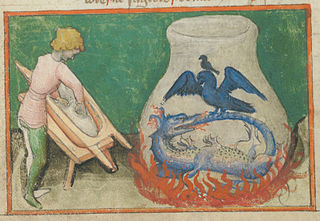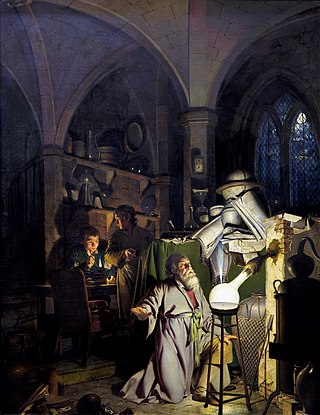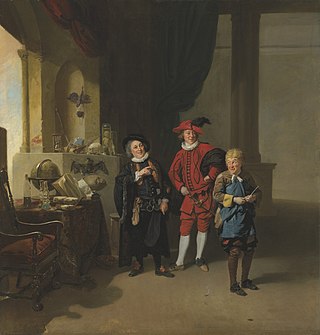Sources
- Austin, H.D. 1937. "Artephius-Orpheus." Speculum 12: 251–54.
- Levi della Vida, G. 1938. "Something More about Artefius and His Clavis Sapientiae." Speculum 13: 80–85.
| Alchemists |
| ||||||||||||
|---|---|---|---|---|---|---|---|---|---|---|---|---|---|
| Writings |
| ||||||||||||
| Various | |||||||||||||
| International | |
|---|---|
| National | |
| People | |
| Other | |
Artephius (or Artefius) (c. 1150) is a writer to whom a number of alchemical texts are ascribed. Although the roots of the texts are unclear and the identity of their author obscure, at least some of them are Arabic in origin. He is named as the author of several books, the Ars sintrillia, Clavis sapientiae or Clavis maioris sapientiae, and Liber secretus. [1]
Alchemical pseudepigraphy makes it difficult to identify who the historical Artephius may have been. His identity remains an open question. As The Secret Book of Artephius was respected and mentioned by Roger Bacon many times, Artephius’ writing is dated to around 1150. [2] One author, Restoro d'Arezzo, conflated Orpheus with Artephius in his Composizione del Mondo in 1282. [3] This mistake was due to a translation error, with the Arabic for Orpheus and Artephius being very similar. This transcription error gave us "Artephius", an alchemist without a historical personality. [4]
Artephius has also been misidentified as a Jewish convert, [5] Apollonius of Tyana, Stephanos of Alexandria, Al-Tughrai, [3] and Ibn Umail. [4] The discovery of a 13/14th-century copy of Clavis Sapientia confirms that the text was first written in Arabic by a Muslim author. [4]
A Renaissance tradition held that Artephius had been born in the first or second century and died in the twelfth, thanks to having discovered the alchemical elixir that made it possible to prolong life. In his Secret Book, Artephius indeed claims to be more than a thousand years old.
In printed form, works attributed to Artephius became well known in the seventeenth century. A work Artefii clavis majoris sapientiae was printed in Paris in 1609. Later it would also appear within Volume IV of Theatrum Chemicum, printed originally in 1613. [6] Then in 1624, Eirenaeus Orandus provided an English translation of the 'secret booke'. [7] The Latin editions of Clavis Sapentia are highly abridged and lack the original diagrams found in the Arabic text. [4]

Alchemy is an ancient branch of natural philosophy, a philosophical and protoscientific tradition that was historically practiced in China, India, the Muslim world, and Europe. In its Western form, alchemy is first attested in a number of pseudepigraphical texts written in Greco-Roman Egypt during the first few centuries AD.

The philosopher's stone is a mythic alchemical substance capable of turning base metals such as mercury into gold or silver. It is also called the elixir of life, useful for rejuvenation and for achieving immortality; for many centuries, it was the most sought-after goal in alchemy. The philosopher's stone was the central symbol of the mystical terminology of alchemy, symbolizing perfection at its finest, divine illumination, and heavenly bliss. Efforts to discover the philosopher's stone were known as the Magnum Opus.

Nicolas Flamel was a French scribe and manuscript seller. After his death, Flamel developed a reputation as an alchemist believed to have created and discovered the philosopher's stone and to have thereby achieved immortality. These legendary accounts first appeared in the 17th century.

The Emerald Tablet, also known as the Smaragdine Tablet or the Tabula Smaragdina, is a compact and cryptic Hermetic text. It was highly regarded by Islamic and European alchemists as the foundation of their art. Though attributed to the legendary Hellenistic figure Hermes Trismegistus, the text of the Emerald Tablet first appears in a number of early medieval Arabic sources, the oldest of which dates to the late eighth or early ninth century. It was translated into Latin several times in the twelfth and thirteenth centuries. Numerous interpretations and commentaries followed.

Mary or Maria the Jewess, also known as Mary the Prophetess or Maria the Copt, was an early alchemist known from the works of Zosimos of Panopolis and other authors in the Greek alchemical tradition. On the basis of Zosimos's comments, she lived between the first and third centuries A.D. in Alexandria. French, Taylor and Lippmann list her as one of the first alchemical writers, dating her works at no later than the first century.

Heinrich Khunrath, or Dr. Henricus Khunrath as he was also called, was a German physician, hermetic philosopher, and alchemist. Frances Yates considered him to be a link between the philosophy of John Dee and Rosicrucianism. His name, in the spelling "Henricus Künraht" was used as a pseudonym for the 1670 publisher of the Tractatus Theologico-Politicus of Baruch Spinoza.
Raphael Patai, born Ervin György Patai, was a Hungarian-Jewish ethnographer, historian, Orientalist and anthropologist.
Axiom of Maria is a precept in alchemy: "One becomes two, two becomes three, and out of the third comes the one as the fourth." It is attributed to 3rd century alchemist Maria Prophetissa, also called Mary the Jewess, sister of Moses, or the Copt. A more detailed quote was provided by the seventh-century alchemistic author called Christianos, who cited that what Maria uttered was "One becomes two, two becomes three, and by means of the third and fourth achieves unity; thus two are but one". Marie-Louise von Franz also gave an alternative version, which states: "Out of the One comes Two, out of Two comes Three, and from the Third comes the One as the Fourth." The axiom served as a recurring theme associated with alchemy for over seventeen centuries.
Petrus Bonus was a late medieval alchemist. He is best known for his Precious Pearl or Precious New Pearl, an influential alchemical text composed sometime between 1330 and 1339. He was said to have been a physician at Ferrara in Italy, causing him to sometimes be known as Petrus Bonus of Ferrara or as Petrus Bonus the Lombard. An Introduction to the Divine Art is also attributed to him but was printed much later, in 1572.

Monas Hieroglyphica is a book by John Dee, the Elizabethan magus and court astrologer of Elizabeth I of England, published in Antwerp in 1564. It is an exposition of the meaning of an esoteric symbol that he invented.

Alchemy has had a long-standing relationship with art, seen both in alchemical texts and in mainstream entertainment. Literary alchemy appears throughout the history of English literature from Shakespeare to modern Fantasy authors. Here, characters or plot structure follow an alchemical magnum opus. In the fourteenth century, Chaucer began a trend of alchemical satire that can still be seen in recent fantasy works like those of Terry Pratchett.

Renaissance magic was a resurgence in Hermeticism and Neo-Platonic varieties of the magical arts which arose along with Renaissance humanism in the 15th and 16th centuries CE. During the Renaissance period, magic and occult practices underwent significant changes that reflected shifts in cultural, intellectual, and religious perspectives. C. S. Lewis, in his work on English literature, highlighted the transformation in how magic was perceived and portrayed. In medieval stories, magic had a fantastical and fairy-like quality, while in the Renaissance, it became more complex and tied to the idea of hidden knowledge that could be explored through books and rituals. This change is evident in the works of authors like Spenser, Marlowe, Chapman, and Shakespeare, who treated magic as a serious and potentially dangerous pursuit.
Abraham Portaleone was an Italian-Jewish physician in Mantua. He was a pupil of Jacob Fano.

Cleopatra the Alchemist was a Greek alchemist, writer, and philosopher. She experimented with practical alchemy but is also credited as one of the four female alchemists who could produce the philosopher's stone. Some writers consider her to be the inventor of the alembic, a distillation apparatus.

The Mirror of Alchimy is a short alchemical manual, known in Latin as Speculum Alchemiae. Translated in 1597, it was only the second alchemical text printed in the English language. Long ascribed to Roger Bacon (1214-1294), the work is more likely the product of an anonymous author who wrote between the thirteenth and the fifteenth centuries.
Chymes was a Greco-Roman alchemist who lived before the third century. He is known only through fragments of text in the works of Zosimos of Panopolis and Olympiodorus of Thebes.
Moses of Alexandria, often known simply as Moses or Moses the Alchemist, was an early alchemist who wrote Greek alchemical texts around the first or second century. He has also been called "Moses the thrice happy". The author of these alchemical texts was likely Jewish, since his writings show traces of Jewish monotheism and other Jewish beliefs.

Shimon Lavi was a Sephardi Hakham, kabbalist, physician, astronomer, and poet. He is credited with the founding of religious institutions and the revival of Torah study in Tripoli, Libya, in the mid-sixteenth century, where he served as spiritual leader and dayan for more than three decades. He authored a commentary on the Zohar titled Ketem Paz and the piyyut, "Bar Yochai", a kabbalistic hymn which became widely popular in the Jewish world. Libyan Jews consider him their greatest scholar.
Solomon or Salomon Trismosin was a legendary Renaissance alchemist, claimed possessor of the philosopher's stone and teacher of Paracelsus. He is best known as the author of the alchemical works Splendor Solis and Aureum Vellus.
Abraham Eleazar is the fictitious author of an alchemical work titled R. Abrahami Eleazaris Uraltes Chymisches Werk. The book was first published in Erfurt in 1735; a second edition was published in Leipzig in 1760.